Mobile Development
Business
mobileapp
app
telemedicine
Telemedicine App Development Guide
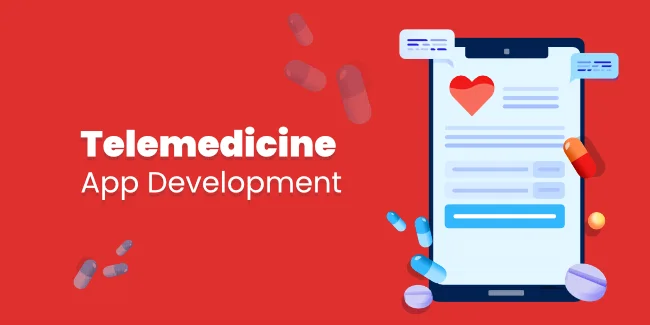
Someone who wishes to contact a doctor must schedule an appointment and visit the physician. It was formerly the case.
Today, most people are under quarantine to prevent the coronavirus epidemic from worsening. Because individuals cannot go outside at such times, contacting a doctor has become much more difficult. New med-tech technologies ensure patients have easier access to medical care.
These solutions are called telehealth apps, which administer medical services to patients and improve their treatment quality.
The goal of telemedicine apps is to assist both patients and their doctors. It has the potential to become a critical component of the healthcare business. It can benefit the sector as a whole if used correctly. Video medical consultations, remote monitoring, telehealth nursing, remote physical therapy, and remote psychotherapy are just a few of the services offered by its applications.
What are Telemedicine Apps for?
Telemedicine apps aren't a new invention. The COVID-19 Pandemic's worldwide lockdown restrictions forced patients and healthcare providers to adopt it as the preferred method of receiving healthcare services. Telemedicine is using technology to enable contact between patients and healthcare professionals. It's a method for delivering healthcare services via remote means.
Patients can talk about their symptoms, medical issues, and the overall health of their bodies with a doctor via real-time video communication, patient portal, etc., and obtain information on the diagnosis, treatment alternatives, and a prescription. Moreover, the doctor has constant insight into the patient's medical history and can use it to find the best treatment.
Benefits of Developing a Telehealth App
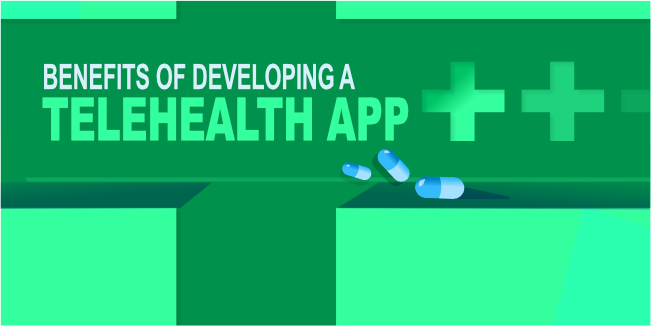
Many people have never utilized telehealth services as part of their medical care. According to a recent poll, only 41 percent of Americans use telehealth services for convenience and the opportunity to talk to the physician of their choosing. So, what advantages do you have that would entice a new customer?
Benefits for Healthcare Providers
Telemedicine app development offers a plethora of benefits to doctors & healthcare professionals. Here are some of the most significant advantages your doctors and other medical personnel will obtain when you create a telemedicine app for your healthcare service.
- Better Patient Reachability - Although this is not always the case, specialists are typically not accessible in every nook and cranny of a nation. The telemedicine app allows physicians to connect with patients at any place with internet access and provide healthcare services
- Efficient Monitoring System - Telemedicine apps include a sophisticated monitoring technology that maintains all patients' medical documents and is accessible anytime and anywhere. As a result, physicians may be able to schedule follow-ups more conveniently.
- Time-Saving - The telemedicine app automates the basic procedure, saving doctors a lot of time.
- Greater Practice Efficiency - Because the telemedicine apps can record every aspect of a patient, doctors may make better judgments. Consequently, more people can be treated since physical presence is no longer required.
Benefits for Patients
Like physicians, patients may also obtain numerous advantages from utilizing telemedicine apps. The following are some of the most significant advantages telemedicine software may provide patients.
- Increasing Patient Care - A telemedicine app's primary goal is to offer the patients the most convenience possible. The patient no longer has to travel for a consultation, as they can contact their doctor via a digital channel instead
- Faster Treatment - Patients who are having minor health issues like a fever or a cold may use these apps to connect with their doctor via their smartphone and receive a prescription in a matter of minutes
- Quick Access to Specialists - Patients may sometimes be unable to discover particular kinds of specialists in their region or town, forcing them to travel long distances for treatment. The telemedicine software allows such individuals to obtain consultation from an expert by simply using their phones.
- Increased Satisfaction - Patients' satisfaction is boosted considerably by telemedicine applications, which allow them to have a more healthy discussion with doctors and give them access to healthcare services 24 hours a day, seven days a week.
Types of Telemedicine Apps
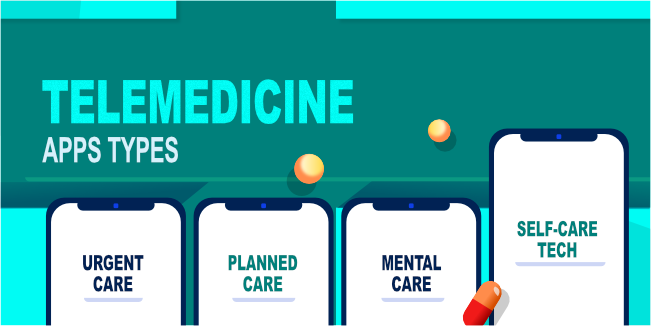
There are several telemedicine app options on the market, and each one includes various distinct features. The majority of them may be classified according to what features they include.
On-demand Urgent Care
Urgent care is a good candidate for digitization. According to McKinsey data, around 20% of hospitals' urgent care may be done digitally.
Developing a custom telemedicine platform in this market would give you video and audio calling services, calendar and schedule management tools, staff administration features, EHR support, and basic document management.
Planned Care
Any healthcare that isn't given in an emergency department is referred to as planned care. Virtualization can also be used for such non-physical treatment.
Virtual planned care is expected to be a tool for following up with the doctor after an in-person visit because, at this moment, only some aspects of a physical examination can be done remotely.
A patient-facing application like this would include secure video and audio calling and text chat, among other patient-facing features such as test result monitoring, scheduling, and so on.
Mental Health
Telepsychiatry applications are becoming increasingly common as patients worldwide become more comfortable doing everyday activities in a video chat environment. Furthermore, delivering mental health services to the patient's home may boost outcomes by enhancing their sense of security and privacy.
Telepsychiatry was effective in treating PTSD, ADHD, and depression when used alone or in combination with other therapies. Such a telehealth application with video and voice chatting could be groundbreaking in the treatment process.
Self-care Tech
Telemedicine has many applications, including wellness. The internet provides limitless resources for anyone interested in getting suited up and performing physical activities from the comfort of their own home. Although several telehealth apps are on the market, few include expert assistance for users. Telehealth as a support system for independent self-care has successfully treated long-term diseases such as heart failure and stroke, respiratory illnesses, and others.
Suppose you are interested in telehealth app development dedicated to self-care. In that case, you'll need to consider integrating other digital goods (such as wearables) and non-video and audio chat options. Push Notifications and education programs made by a good development team are also required.
What Should a Telemedicine App Contain?
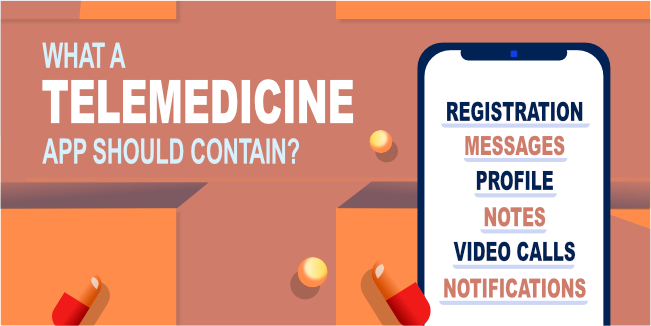
There are certain telemedicine app features that every application must contain. But some require a special approach and should be properly used due to their intended use. As with the benefits, the same with the specific elements, the patient and the doctor need something else to be satisfied.
App for Patients
Patients are people who need help with their problems. It is for them that the application should be the most transparent and universal. After all, treatment over the phone may be required by a person who is fluent in using a smartphone, but also by someone who does not use a mobile phone daily. So let's focus on what the patient telemedicine application must-have.
- Registration - You're mistaken if you believe this is a simple function. To develop a Telemedicine app with a working registration feature, you must adhere to EHR integration standards (not to mention a slew of other regulations), document uploads, and data security. Third-party integrations such as Facebook, cell phone providers, and email service providers should also be considered. Remember that the first screen must contain data privacy and other policy terms accessible.
- Personal Profile - Patients should be able to establish their preferences, choose a location, and synchronize their records with those at other hospitals. It will allow patients to schedule individual appointments and give doctors important information before the encounter.
- Video Chat - The key feature of most telemedicine products is video chat. Moreover, HQ video conferencing and audio contact are a must, not in the least because doctors use visual cues to determine their diagnosis.
- Text Messaging - Issues that are too minor to be addressed in a video conference shouldn't be mentioned. Instead, they may be resolved through text messages. Patients should also be able to exchange multimedia with their doctors using this method of communication.
- Calendar - Some telemedicine solutions will require calendar and scheduling functions. Patients should be able to view a doctor's available appointment times as well as their scheduled appointments as well as reschedule them if they wish. The patient should be notified of confirmation once the doctor has approved the requested appointment. Google Calendar integration is also required.
- Notifications - Notifications are a great way to stay on top of things when you're traveling. They may be used to notify customers about anything from monthly or annual visits to prescription renewals and doctor appointments, allowing you to keep track of everything. In developing an app serving medical services, you must ensure that medical professionals' recommendations are visible. Notifications are the best way to do that.
- Reviews - And last but not least, the reviews. Patients should be able to examine their appointments, and physicians should be able to learn from feedback. Doctors can monitor their performance and make improvements by gathering data. Furthermore, it will enable patients to get more information about the specialists they're conversing with.
App for Doctors
The application should be two-sided, with a focus on both the patient and the doctor who is treating them. It should also be simple for the doctor to use. It should optimize work organization in the first place.
- Doctor's Profile - Doctors should list their degrees and credentials, such as education, internships, employment history, and certifications. Their profiles should also include information from within the hospital, such as evaluations, shifts, and important hospital news.
- Electronic Health Records - When doctors are informed of an appointment, they should be given access to the patient's medical file. It is critical to provide a competent diagnosis and treatment recommendation. The telemedicine solution can add additional functions such as the patient's therapy history, graphs with treatment evolution, and eRx.
- Video And Text Communication - Doctors and patients can communicate using video and text, much like today. Doctors might need to contact patients after an appointment for follow-ups or findings, so keep that in mind when shopping for phones. As a result, text messages are vital since they allow the doctor to communicate directly and immediately with the patient without requiring another visit.
- Internal Data Exchange - Physicians may need to communicate information and medications between departments. For example, a doctor might transfer their patient to a specialist. There will need to be a seamless exchange of internal data for this to happen.
Telemedicine App Development Cost
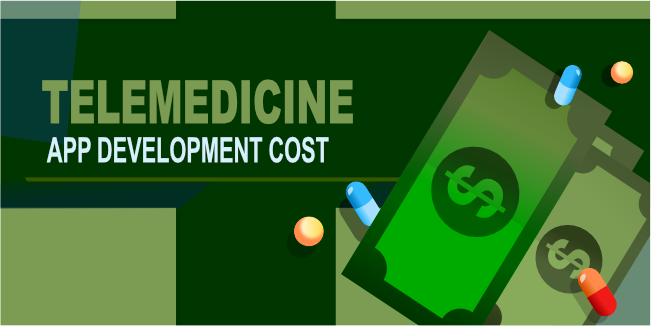
There is no one price for telemedicine app development because so many variables are involved. The most crucial element is whether you will choose remote telemedicine software development services or create your in-house team. However, beyond that, any development process will be unique, except for the basic structure.
Discovery
The Discovery stage is the first phase of the process, which covers everything you need to know about creating an app in the healthcare industry. Global telemedicine market research and developing a go-to-market strategy are among the tasks included in this phase. Deciding on the infrastructure and architecture for the telemedicine app is also part of this stage's work. Because each component affects other components, all this work must be done concurrently.
A business analyst, a designer, and an architect are all typical members of the discovery phase of product development. It might take weeks to months to finish depending on the extent and depth of their work.
Building an MVP
After all of the business-related details are settled, development can begin. On your team, you'll require a Project Manager, Tech Architect, Developers, Quality Assurance Engineers, and Designers for every project.
MVPs are, as their name implies, minimal viable products that serve to test the concept and see whether it will have a market.
This stage, which lasts approximately two months, is the longest. It's essential to remember that in a business sense, rather than in a technological or design one, getting it up and running is far more significant than perfecting it. MVPs are thus notoriously buggy and lacking in capabilities from a commercial standpoint. From there, we arrive at the next stage.
Maintenance
After launch, the telemedicine app developers begin work on support and further development. At this stage, the developer team may be smaller than the original, yet their work on the app continues like before. The staff works through existing problems while BAs focus on the product's flow and determine where to go next.
This stage of telemedicine app development is continuous. It goes on as long as the product exists, so no real timeline or cost can be estimated.
For more information on how to create an MVP and add new features, read our guide on the step-by-step procedure for developing a telehealth product.
Telemedicine App Development Tips
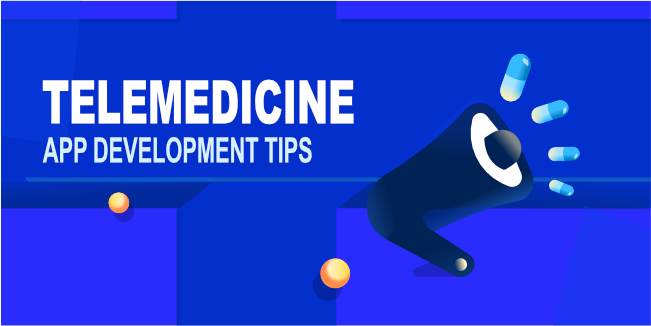
Telemedicine is typically a low-risk procedure. However, telemedicine has certain unique risks associated with it, including patient safety and practice liability. Adapting routine procedures around informed consent, documentation, and other standard elements of a patient encounter, as well as changing the practice's insurance coverage, are all necessary to minimize these hazards.
The following are three suggestions for any medical or dental practice that uses telemedicine to provide treatment.
Again, Research the market
The first step is to prepare a work plan and collect project specifications. It is the definition of a discovery phase in a nutshell. The success of your project will be determined by how precisely you define goals, calculate the project duration, and set future actions. This stage, known as the research and development stage, involves your outsourcing development firm assessing project complexity and determining what features to include, testing the product's market viability, establishing deadlines, selecting required technologies, defining expectations on budget, and planning a task.
Select Platform
Before you start coding and designing your telemedicine app, do plenty of studies and select the platform on which it will operate. There are three basic methodologies for creating a telemedicine application:
- Native App Development - Using the right technologies and tools, you can build your app on a specific platform (for example, iOS or Android). This method entails utilizing unique technologies and tools for a certain platform.
- Cross-platform App Development - Compatibility between mobile operating systems is handled by software applications, also known as hybrid apps. To put it another way, this technique lets developers create a single source of code that may be used on numerous platforms simultaneously.
- Web App Development - Apps that integrate remote servers and run on mobile devices are known as hybrid apps. It is an excellent method to be accessible to both mobile and desktop users.
Focus on UI/UX
If your design doesn't meet users' demands and expectations, it's useless. The main goal of UI/UX in telemedicine apps is to provide all necessary information and make navigation easier for patients and medical practitioners.
Engage UX/UI designers that specialize in building discoverable, effective, and user-friendly healthcare interfaces. An expert will customize the logic, navigation, and layout to meet the demands of all intended users to guarantee optimal user experiences. The following are some helpful design suggestions for obtaining the results you desire:
- Easy-to-follow onboarding - Most medical personnel, especially earlier generations, aren't computer-literate enough. As a result, when creating a telemedicine app, it's critical to ensure that the onboarding procedure is simple and intuitive. You might offer users useful hints on how to get through the program, so they know the fundamentals. Comprehensible onboarding procedures entice people to use your app by demonstrating that you care from the start.
- Usability - The usability of this telemedicine software is poor; therefore, it has a low probability of succeeding despite its innovative concept in healthcare. Keep simplicity and ease of use as your top priorities. Ensure all necessary features are accessible on the dashboard, with all buttons and icons clearly labeled. Healthcare professionals and patients can now quickly resolve their issues without having to look for the appropriate function because of this clarity.
- Modern UI - One of the most crucial parts of any good user experience is color. Selecting a pleasant color palette, sensible button sizes, easily readable typefaces, and screen element placement to improve UX is an important thing to remember. Remember your company style and double-check that all design elements are consistent.
- Personalization - Not only do people's needs, goals, and preferences vary from patient to patient, but they also differ significantly depending on their personalities. Understanding your users' requirements and objectives is crucial for a successful user experience. Customization is an effective method of making your product stand out and be more helpful. Orlando Health uses data from patients to provide customized communication to new moms, such as personalized emails/notifications that address their questions. The newborns may select a preferred track to focus on caring for the youngster and receive personalized emails/notifications about relevant topics.
Security Matters
Security is essential in the healthcare sector since it handles personal data. A single security vulnerability may ruin your reputation, and your consumers will quickly abandon you. Some best practices can help you keep your app's security at an excellent level. As a result, here are some of the most important measures:
- High-Level Authentication - It's crucial to use two-step verification for SMS passwords alone isn't sufficient. It's preferable to integrate various technologies. For example, you may employ multi-factor authentication (such as voice, facial, or fingerprint recognition) or ask users to change their passwords every two months. Furthermore, it's better to restrict the number of login attempts than risk account hacking or data leakage by limiting these attempts.
- Data Backup - It's critical to back up your data regularly when performing certain procedures with data to avoid losing electronic health information. Data backup is essential if you lose data since it allows you to restore all of it quickly.
- Access Restriction - To safeguard the patients' health insurance portability and data, restrict access to it only to authorized personnel.
Conclusion
Conclusion Telemedicine app development isn't as simple as you may believe. However, creating a telemedicine app might be beneficial to your organization. All the effort put into development can pay off with good sales and simply earning money on the application.
Apps of this sort bring revenue to the developers and benefit the end-users. The true value of a medical app is measured by its capacity to improve people's health. You may also increase the appeal of your software by hiring a professional group to help you. It is an excellent opportunity to trust outsourcing and hire a mobile app development company.